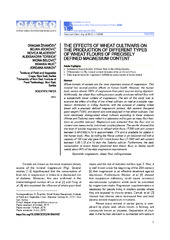Приказ основних података о документу
The effects of wheat cultivars on the production of different types of wheat flours of precisely defined magnesium content
| dc.creator | Živančev, Dragan | |
| dc.creator | Jocković, Bojan | |
| dc.creator | Mladenov, Novica | |
| dc.creator | Torbica, Aleksandra | |
| dc.creator | Belović, Miona | |
| dc.creator | Mijić, Branka | |
| dc.creator | Ninkov, Jordana | |
| dc.date.accessioned | 2021-04-26T19:50:15Z | |
| dc.date.available | 2021-04-26T19:50:15Z | |
| dc.date.issued | 2020 | |
| dc.identifier.issn | 1451-9372 | |
| dc.identifier.uri | http://fiver.ifvcns.rs/handle/123456789/1957 | |
| dc.description.abstract | Whole kernels of cereals are the most important source of magnesium. This mineral has several positive effects on human health. However, the human body cannot absorb 100% of magnesium from plant sources during digestion. Additionally, the wheat flour milling process usually produces refined flour with a substantially lower content of magnesium. The aim of this study was to examine the effect of milling of two wheat cultivars on total and soluble magnesium distribution in milling fractions, with the purpose of creating wheat bread with a precisely defined magnesium content. Ash content, thousand grain weight (TGW), and kernel size were analysed in five wheat cultivars. Two most statistically distinguished wheat cultivars according to these analyses (Moma and Todorka) were milled in a laboratory mill to gain as many flour frac-tions as possible (eleven). Magnesium was extracted from the flour and its content was measured by inductively coupled plasma. The results showed that the level of soluble magnesium in refined white flours (T-500 with ash content between 0.46-0.60d. m.%) is approximately 17% and is available for uptake in the human body. Also, by milling the Moma cultivar in an industrial mill with a capacity of 100 t per day gave 6.6 t more brown flour (T-1000 with ash content between 1.05-1.15 d.m.%) than the Todorka cultivar. Furthermore, the daily consumption of brown bread (produced from brown flour) in Serbia would satisfy about 60% of the daily magnesium requirements. | en |
| dc.publisher | Savez hemijskih inženjera, Beograd | |
| dc.relation | info:eu-repo/grantAgreement/MESTD/Technological Development (TD or TR)/31066/RS// | |
| dc.relation | info:eu-repo/grantAgreement/MESTD/Technological Development (TD or TR)/31007/RS// | |
| dc.rights | openAccess | |
| dc.rights.uri | https://creativecommons.org/licenses/by-nc-nd/4.0/ | |
| dc.source | Chemical Industry & Chemical Engineering Quarterly | |
| dc.subject | magnesium | en |
| dc.subject | wheat | en |
| dc.subject | flour | en |
| dc.subject | milling process | en |
| dc.title | The effects of wheat cultivars on the production of different types of wheat flours of precisely defined magnesium content | en |
| dc.type | article | |
| dc.rights.license | BY-NC-ND | |
| dc.citation.epage | 7 | |
| dc.citation.issue | 1 | |
| dc.citation.other | 26(1): 1-7 | |
| dc.citation.rank | M23 | |
| dc.citation.spage | 1 | |
| dc.citation.volume | 26 | |
| dc.identifier.doi | 10.2298/CICEQ181004019Z | |
| dc.identifier.fulltext | http://fiver.ifvcns.rs/bitstream/id/884/1954.pdf | |
| dc.identifier.scopus | 2-s2.0-85084004563 | |
| dc.identifier.wos | 000528214600001 | |
| dc.type.version | publishedVersion |


